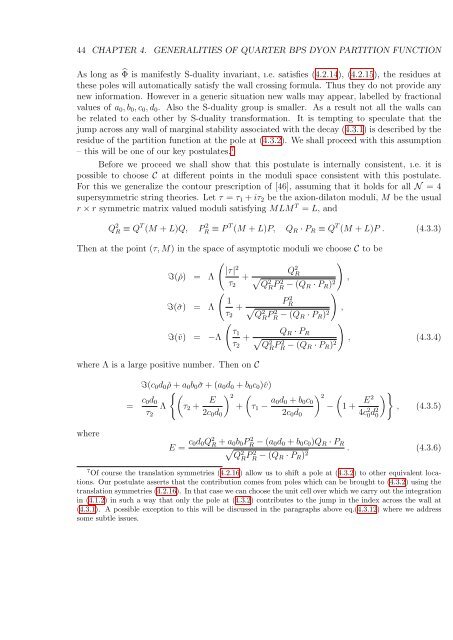PHYS08200604018 Shamik Banerjee - Homi Bhabha National ...
PHYS08200604018 Shamik Banerjee - Homi Bhabha National ...
PHYS08200604018 Shamik Banerjee - Homi Bhabha National ...
Create successful ePaper yourself
Turn your PDF publications into a flip-book with our unique Google optimized e-Paper software.
44 CHAPTER 4. GENERALITIES OF QUARTER BPS DYON PARTITION FUNCTION<br />
As long as ̂Φ is manifestly S-duality invariant, ı.e. satisfies (4.2.14), (4.2.15), the residues at<br />
these poles will automatically satisfy the wall crossing formula. Thus they do not provide any<br />
new information. However in a generic situation new walls may appear, labelled by fractional<br />
values of a 0 , b 0 , c 0 , d 0 . Also the S-duality group is smaller. As a result not all the walls can<br />
be related to each other by S-duality transformation. It is tempting to speculate that the<br />
jump across any wall of marginal stability associated with the decay (4.3.1) is described by the<br />
residue of the partition function at the pole at (4.3.2). We shall proceed with this assumption<br />
– this will be one of our key postulates. 7<br />
Before we proceed we shall show that this postulate is internally consistent, ı.e. it is<br />
possible to choose C at different points in the moduli space consistent with this postulate.<br />
For this we generalize the contour prescription of [46], assuming that it holds for all N = 4<br />
supersymmetric string theories. Let τ = τ 1 + iτ 2 be the axion-dilaton moduli, M be the usual<br />
r × r symmetric matrix valued moduli satisfying MLM T = L, and<br />
Q 2 R ≡ Q T (M + L)Q, P 2 R ≡ P T (M + L)P, Q R · P R ≡ Q T (M + L)P . (4.3.3)<br />
Then at the point (τ, M) in the space of asymptotic moduli we choose C to be<br />
(<br />
)<br />
|τ| 2<br />
Q 2 R<br />
I(ˇρ) = Λ + √<br />
τ 2 Q<br />
2<br />
R<br />
PR 2 − (Q ,<br />
R · P R ) 2<br />
(<br />
1<br />
I(ˇσ) = Λ +<br />
τ 2<br />
I(ˇv) = −Λ<br />
where Λ is a large positive number. Then on C<br />
I(c 0 d 0 ˇρ + a 0 b 0ˇσ + (a 0 d 0 + b 0 c 0 )ˇv)<br />
{ (<br />
Λ τ 2 + E ) 2<br />
+<br />
2c 0 d 0<br />
= c 0d 0<br />
τ 2<br />
)<br />
PR<br />
2 √<br />
Q<br />
2<br />
R<br />
PR 2 − (Q ,<br />
R · P R ) 2<br />
(<br />
)<br />
τ 1 Q R · P<br />
+ √ R<br />
τ 2 Q<br />
2<br />
R<br />
PR 2 − (Q , (4.3.4)<br />
R · P R ) 2<br />
(<br />
τ 1 − a 0d 0 + b 0 c 0<br />
2c 0 d 0<br />
) 2 )<br />
−<br />
(1 } + E2<br />
, (4.3.5)<br />
4c 2 0d 2 0<br />
where<br />
E = c 0d 0 Q 2 R + a 0b 0 PR 2 − (a 0d 0 + b 0 c 0 )Q R · P<br />
√ R<br />
Q<br />
2<br />
R<br />
PR 2 − (Q . (4.3.6)<br />
R · P R ) 2<br />
7 Of course the translation symmetries (4.2.16) allow us to shift a pole at (4.3.2) to other equivalent locations.<br />
Our postulate asserts that the contribution comes from poles which can be brought to (4.3.2) using the<br />
translation symmetries (4.2.16). In that case we can choose the unit cell over which we carry out the integration<br />
in (4.1.2) in such a way that only the pole at (4.3.2) contributes to the jump in the index across the wall at<br />
(4.3.1). A possible exception to this will be discussed in the paragraphs above eq.(4.3.12) where we address<br />
some subtle issues.

















